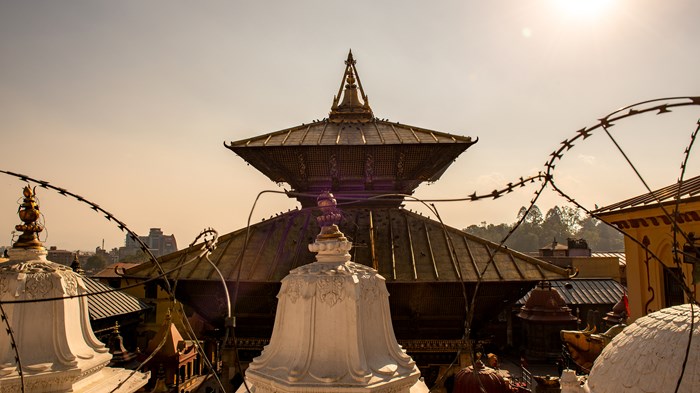
More than 15 years after Nepal officially became a secular democracy, the former Hindu monarchy may have a religious extremism problem, incited and aggravated by its closest neighbor.
In an “alarming” development, Indian Hindutva ideology and politics have begun to spread throughout the country, as local experts and journalists report. This proliferation has resulted in a recent spate of attacks and restrictions on Christians reported within the country of 30 million.
According to local sources, at least five separate incidents targeting Christians have been reported in March and April of this year.
“The Hindu Swayamsevak Sangh (HSS) in Nepal is rapidly growing. Aiming to protect Hinduism, they degrade Christianity and badmouth us through social media and other sources,” said Kiran Thapa, who was arrested last month for praying for people in Kathmandu.
In March, Thapa and several foreigners, all Christians, were visiting the Pashupatinath Temple, a religious World Heritage Site deeply venerated by local Hindus. When they entered the temple, they came across an elderly couple who were suffering with pain in their knees and back. The group offered to pray for them with the couple’s consent, and they subsequently reported that they were healed. More people then requested prayers from the group and reported being healed.
“I had to request them to come one by one,” said Thapa.
After two monks asked for prayer and then reported that they too had been healed of their physical afflictions, a policeman ordered the Christians to leave the Hindu temple for praying in Jesus' name. As they were leaving, a man with an immobile hand followed the group out. When the Christians prayed for him in the street, having informed him that they could not pray for him in the temple, he also said he had been healed. Despite the miracle occurring outside the temple grounds, the incident angered the same policeman, who then got a senior police official to deal with the matter. According to Thapa, the officer began screaming at Thapa and arrested him.
“They threatened to kill me and bury me as an anonymous corpse near the ghat (riverbed). ‘If the law had not bound my hands, I would have killed you and buried you here,’ the officer told me,” said Thapa.
Thapa spent the next 24 hours in extremely poor jail conditions without a proper place to sit or sleep. The senior inmates made him sit near the toilet while lavatory waste gushed out into the cell, said Thapa.
Authorities released him after the temple management, which had filed a complaint against Thapa that falsely stated he was distributing Bibles, withdrew their complaint at the request of Thapa’s wife.
Several weeks earlier, evangelist Sajan Shrestha mentioned, a video was uploaded on Facebook showing members from HSS, an extremist organization whose name literally translates to “Hindu emperor army,” aggressively bullying Christians. The mob taunted the crowd, calling on them to tear the Bibles. All resisted but one, who tore the Bible and then was forced to trample the torn book under his feet. The extremists then heaped all the Bibles and set them on fire. They surrounded the fire and shouted slogans like “Jai Shri Ram” (Hail, Lord Rama).
“We are so sorry for our brothers who went through all this,” said Shrestha, who himself was harassed, detained, and interrogated by a pro-Hindu journalist and two plainclothes policemen on February 12. Earlier that month, the journalist had found Shrestha’s name after threatening two young Christian women who were distributing tracts in Lalitpur, the country’s fourth most-populous city. After local Christians protested, authorities released him from police custody.
Historically, Hindus in Nepal have been far less aggressive toward non-Hindus than their counterparts in India, Shrestha said. However, he has observed a concerning evolution of attitudes in Terai, a region in southern Nepal close to where the country borders India.
According to Shrestha, in the weeks leading up to India’s national elections, which begin at the end of April, Indian Hindu extremist ideologies seem to be gaining ground. He believes that Indian prime minister Narendra Modi’s Bharatiya Janata Party (BJP) is financially supporting these Nepali Hindu groups to deliberately fuel religious tensions, possibly for political leverage.
In March, seven Australians and four Nepalese were visiting a village in Terai when a Hindu group from another village confronted them aggressively, stating they couldn't be there and accusing them of trying to convert the locals to Christianity. The villagers subsequently called the police, who arrested the entire team.
Further, within hours of their arrest, a mob of around 40 people surrounded the police station, demanding the Christians be charged for preaching in the Hindu-majority area.
After being detained in Kathmandu for three days, the Australians were asked to leave Nepal. However, the government kept the four Nepalese, Adesh Gurung, Bijendra Mukhiya, Phurba Lama, and Siwan Rai, in jail for more than three weeks.
The four men were charged under Nepal's Penal Code adopted in 2015, which prohibits proselytization. More stringent anti-conversion laws were passed in 2017, under which a person can be sentenced to a jail term of up to five years and a fine of up to 50,000 Nepali rupees ($375 USD) as punishment.
“Even though the law states that the fine could be up to 50,000 Nepali rupees, the four Christians were released on a bail bond of 150,000 Nepali rupees each,” said one of the Australians to CT.
However, leading up to their trial, the four will have to return every three months to present themselves in the court while they are out on bail. Once the trial begins, they will have to be present for every court date (which could be once or twice a month) until the verdict.
The vehemence of the mob’s response surprised the Australian missionary, who told CT he had previously visited the Christian homes in the village without issue and intimated that Indian Hindu radicals have been crossing the border and inciting violence.
“This whole region has become more anti-Christian and zealous in trying to get rid of Christians in the last six months. The Hindu extremists are organizing people to report Christians,” he said. “In our case, the host did not report us, but someone reported our presence in the village, and it was surprising to see so many people gathered swiftly, which demonstrates their planning. Their minds are being polarized. The attitude of surrounding us, gathering quickly, and calling the police is coming over from the Indian border—hatred and extreme thinking.”
The HSS—the body promoting Hindutva in Nepal—was founded in the country around 1992 by several Nepali students who had been exposed to the ideology of the Indian Hindu nationalist organization Rashtriya Swayamsevak Sangh (RSS) while studying in India.
Though the HSS has distanced itself from the RSS, the RSS nevertheless considers the HSS its international wing. With 750 branches in 45 countries, the HSS has chapters in English-speaking nations like the UK, the United States, and Canada, as well as European countries like Germany, Norway, Denmark, Finland, and others.
“The HSS is expanding quickly and promotes Hindu nationalism. Sadly, they often depict Christians in a negative light, portraying themselves as the better option. This has resulted in many incidents where Christians are targeted unfairly,” said Thapa.
The HSS is not the only group working to build a Hindu nationalist narrative in Nepal. The Kathmandu Post reported that at least 100 Hindu organizations are currently active in Nepal. The article and others also mention foreign influences, mainly from India, backing the Hindutva movement, adding complexity to Nepal's political landscape.
“There is a massive rise in the pro-Hindu movement across Nepal in the last two to three years,” said an official who spoke to The Kathmandu Post on condition of anonymity alleging that some organizations promoting the Hindu movement in Nepal are volunteer groups while “others have received funds from different sources inside and outside the country.”
While indigenous ethnic Nepalis are not traditionally Hindu, many Hindus have been successful in convincing them that their faith alone protects tribal identity. In contrast, Christians are cast as outsiders trying to erase and undermine local culture.
India and Nepal share strong cultural, social, and economic ties. They signed agreements in 1950 and 1960 to strengthen economic cooperation and promote trade. The open border allows free movement of people and goods, making Nepal one of India's top export destinations. India provides significant foreign investment and development aid to Nepal in areas like education, infrastructure, energy, and rural development. The two countries recently signed a deal allowing the Indian government to directly fund projects in Nepal worth up to 200 million Nepali rupees ($15 million USD), an increase from the previous 50-million-rupee limit per project.
Shrestha said that the Nepali Christian leadership is planning to bring this sudden rise in incidents against the Christian community before the authorities.
“We are planning to visit the prime minister [Pushpa Kamal Dahal] and human rights organizations and alert them about these incidents,” said Shrestha.
Despite the rise of radical Hinduism, Nepal's census shows a significant 68 percent increase in the Christian population in the past decade. The numbers further reveal a small decline in Hinduism and Buddhism followers, compared to the modest growth of the Muslim, Christian, and Kirat communities (indigenous ethnic groups of the Himalayas) compared to the 2011 census.
While Hinduism is still over 80 percent, its share has decreased from 81.3 to 81.19 percent, and Buddhism from 9 to 8.2 percent. Meanwhile, Islam rose from 4.4 to 5.9 percent, Christianity surged from 0.1 to 1.76 percent, and the Kirat community increased from 2.81 to 3.17 percent. (Nepal also has minor religions like Bahai, Bon, Jain, Prakriti, and Sikh.)

Support Our Work
Subscribe to CT for less than $4.25/month


















